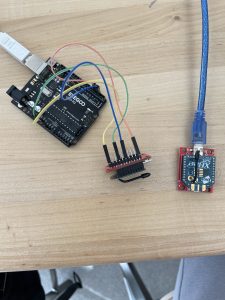This week, I spent a lot of time getting the drone ready for PID tuning and setting up the various components required to relay coordinates back to the base. I began the week by attaching all the motors to the drone, testing them to ensure they all worked, and setting up the polarity so the drone could properly take off.
However, as discovered last week, our propellers don’t fit properly onto the motors. Thus, we spent some time talking with techspark experts to figure out a method to drill into the propeller. After many trials and various techniques, we couldn’t figure out a proper method to drill into them. Therefore, we decided to change our motors instead so that the properllers are compatible. Once we changed the motors, we again had to perform testing to make sure they all worked and set their polarity correctly. We found out that the required voltage for these motors are lower that the ones we were previously using, thus, we realized the need to order a different battery. But to continue testing while the batteries were being ordered, we set software constraints to ensure the motor operated safely.
On the other hand, I spent some time setting up the radio mechanism for the drone. This required me to set up the radios by installing the correct firmware, setting up its configurations, and interfacing with them to read data. Once these aspects were figured out, we were able to send data between the radios. The next step was to set up the radio such that one will be connected with the arduino board and one to my laptop (base station). I wrote code such that the arduino can understand the radio and read its values. Once this was set up, I tested the radio by sending messages from both sides of the radio to one another. We saw that the radio was working as expected.
The next steps are being able to interface with the GPS to transmit its values over by radio and connect the computer vision to the Arduino as well.

